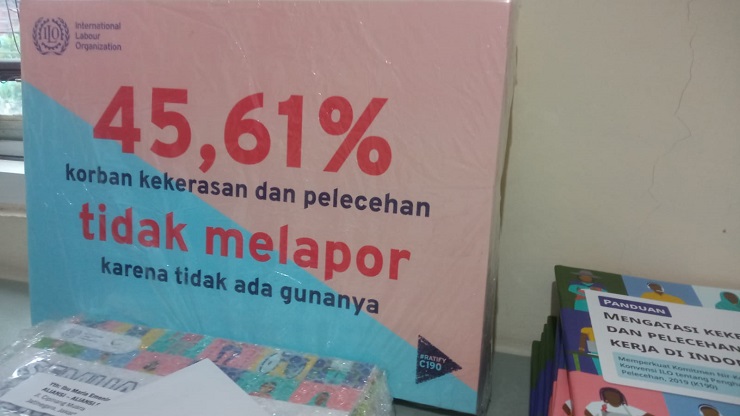ACVCSCIASIA.ORG, JAKARTA – The ILO raises the awareness of Indonesian trade union confederations to be part of the actions to create workplaces that are free from violence and harassment, including online gender-based violence.
The establishment of a task force on sexual harassment at work, the inclusion of issues on harassment and violence at work into the collective bargaining agreement, internal campaigns for a harassment free workplace as well as social media campaigns were some efforts that have been taken by the national trade unions confederations in Indonesia shared during the ILO’s workshop on the promotion of safe working environment on 13 April in Jakarta.
Attended by around 60 trade unionists from national trade union confederations, the workshop focused on harassment and violence issues at work, particularly online gender-based violence. The workshop was conducted in conjunction with the observation of the World Day for Safety and Health at Work which annually falls on 28 April and the promotion of the ratification of the ILO Convention No. 190 on Violence and Harassment (C190) .
“The scope of occupational safety and health (OSH) also includes the right of workers to work in a safe and healthy working environment that are free from violence and harassment. It is in line with this year’s theme of the World Day and trade unions play an important role to safeguard this right,” said Dyah Sudarto, ILO’s Programme Coordinator for C190 on Work Violence and Harassment.
Responding to the fast advancement of technology and the new trend of digital teleworking, the workshop presented resource persons from the ICT Watch, a civil society organization dealing with digital literacy and awareness. Ida Ayu Prasasti, Programme Director of ICT Watch, quoted the ILO’s latest research on the vulnerability of Indonesian workers to violence and harassment in the world of work.
Jointly conducted with the Never Okay Project, an organization deals with sexual harassment issues, the research found that 70.81 percent of Indonesian workers had experienced violence and harassment at work and 39.06 percent of the violence and harassment incidents occurred online.
“With more than 200 million users of internet in Indonesia, online gender-based violence have become more rampant. The causing factors include the gap in authority relations, lack of OSH understanding related to psychosocial issues, patriarchal culture, lack of effective policy and procedural mechanism and lack of awareness about this issue,” she explained.
During the interactive session, she encouraged the participating trade unionists to share their experiences. Some participants admitted that they were also vulnerable to the violence and harassment causing them to feel insecure and powerless. The male participants even admitted that they were also vulnerable to sexual harassment from their superiors.
Ida Ayu reminded that the violence and harassment at work could happen to anyone. Thus, she further elaborated 10 types of online gender-based violence: Cyber grooming, cyber harassment, cyber stalking, impersonating, sexting, cyber bullying, doxxing, cyber hacking, dissemination of intimate contents and sextortion.
“By having a better understanding and adequate knowledge about these different types of online gender-based violence, it is hoped that we can avoid negative impacts that can cause psychological harms, social exclusion, economic exclusion and limited mobility,” she added.
To equip the participating trade unionists with a digital skill to protect their own digital accounts, the workshop also included the session on digital safety. Indriyatno Banyumurti, Executive Director of ICT Watch, introduced types of digital frauds and an applicative tool to better protect personal digital accounts. During the practical session, some participating trade unions just learnt that their personal emails have been hacked several times and their chosen passwords were considered weak and easy to be hacked.
“This is very informative and applicative. In addition to be aware about issues related to work violence and harassment, including the online types, we also need to better protect our digital accounts,” said Maria Emeninta, the Commission of National Equality of the Confederation of All Laboour Union (KSBSI).
The workshop was concluded with the distribution of a reference platform on informational materials related to online gender-based violence that is available at s.id/kbgokerja and the safe digital tools at s.id/amanbergerak .
The participating trade unions confederations were: The Confederation of All Indonesian Labour Union (KSBSI), the Confederation of All Indonesian Trade Union (KSPSI), the Confederation of All Indonesian Trade Union-CAITU (KSPSI-CAITU), the Confederation of the Indonesia Trade Union (KSPI), the Confederation of National Trade Union (KSPN) and the Confederation of Indonesian Moslem Labour Union (K-Saburmusi). (source:ILO)
As known, The International Labor Organization (ILO) released the results of a survey on Violence and Harassment in the Indonesian Workplace 2022. This survey was conducted during the survey period 12 August - 13 September 2022 based on the experience of workers in Indonesia in the last 2 years (2020-2022). Quoting from ILO data that there were at least 10 important findings from a total of 1175 respondents including,
1. 70.81% have been victims of violence and harassment in the world of work. 72.77% had witnessed violence and harassment in the world of work. 53.36% have been victims as well as witnesses of violence and harassment in the world of work.
2. Many victims experienced more than 1 form of violence and harassment! 69.35% of victims experienced more than 1 form of violence and harassment.
3. Violence and psychological abuse are most often experienced! Followed by violence and sexual harassment. 77.40% of victims experienced violence and psychological abuse. 50.48% of victims experienced violence and sexual harassment.
4. Bosses/senior co-workers are most often the perpetrators! This confirms the imbalance of power relations between perpetrators and victims. 54.81% of perpetrators were superiors/senior colleagues.
5. Violence and harassment in the world of work can occur in various workplaces, both in person and online. 69.83% in the office/workspace. 39.06% occurred online, 21.88% in the field and outside office buildings.
6. The victim has mental health problems and wants to resign. 63.22% are angry and feel uncomfortable. 55.05% mental health disorders (depression, anxiety, stress, fear, etc.). 47.00% want to leave the company/institution.
7. 45.61% of victims did not report because they felt that HR/Management would not do anything. 37.79% Worried that no one will believe it. 37.52% Worried about affecting career.
8. Good news!. Many witnesses are active in helping victims. 54.74% Ask about the condition of co-workers who are victims. 37.66% helped the victim to be able to take further action to handle the case.
9. Victim blaming still happens! 18.99% Victims are blamed for cases of violence and abuse experienced.
10. Lack of anti-violence and harassment mechanisms owned by companies/institutions. 34.53% of respondents admitted that there was no mechanism at work.
The expectations that can be drawn from this survey on violence and harassment in the world of work include, There will be no more cases of violence and harassment in the world of work. The government immediately ratifies ILO Convention 190 and disseminates it to the public. Companies in Indonesia can apply regulations to prevent and deal with harassment and violence in the world of work.
Not only that, the ILO has also issued a guidebook on addressing violence and harassment in the world of work in Indonesia. Strengthen commitments to nonviolence and embrace the ILO Convention on the Elimination of Violence and Harassment, 2019 (K190).


